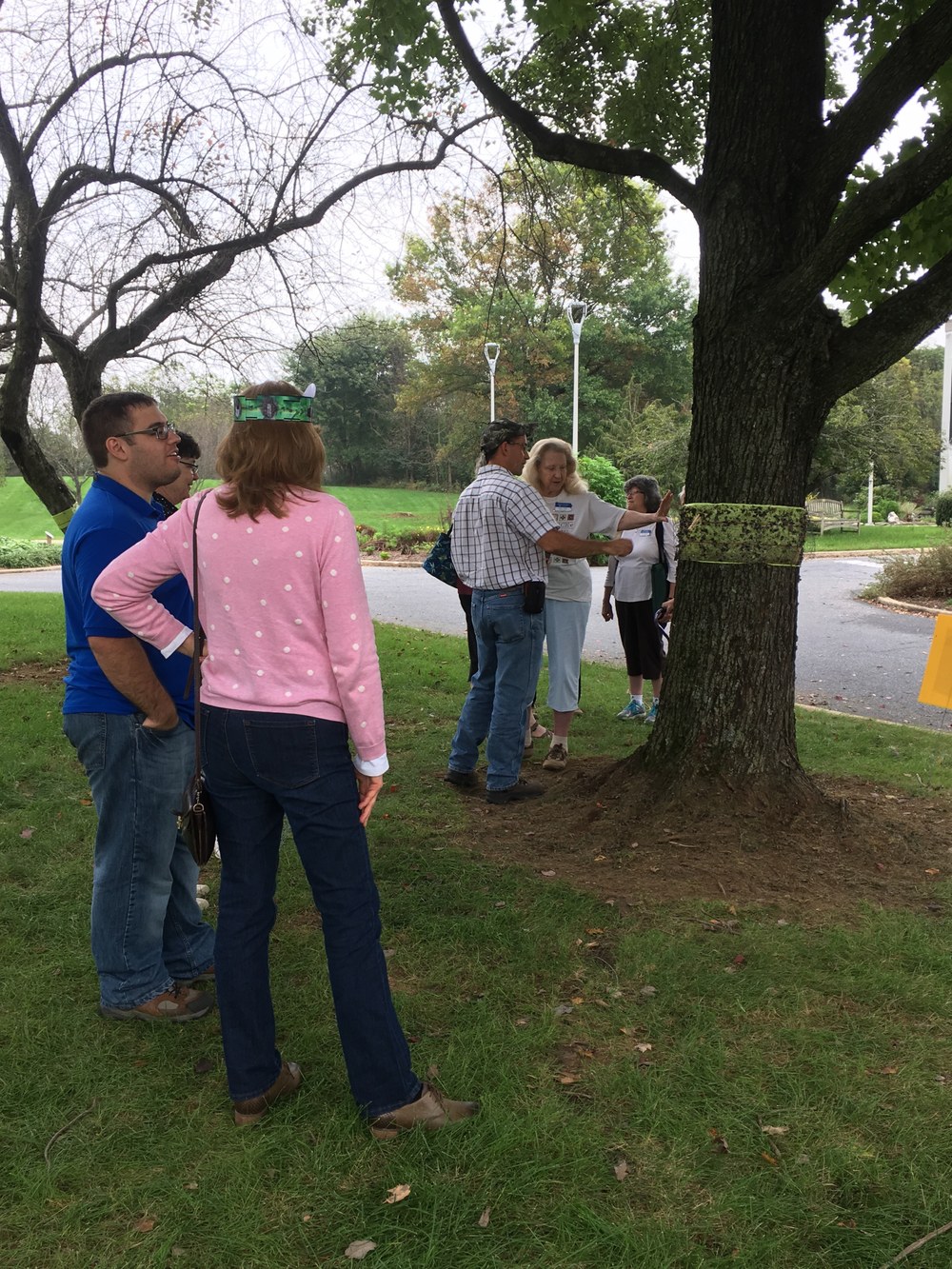The invasive Spotted Lanternfly insect has been a focus for Penn State Master Gardeners since its arrival to Pennsylvania from Southeast Asia. While it is primarily an agricultural threat to our state, this insect can impact every resident in areas where infestation is intense.

Spotted lanternfly banding
The Pennsylvania Infestation
The spotted lanternfly (SLF) is an invasive sap-sucking planthopper from southeast Asia, first discovered in the United States in Berks County in 2014. This was the first recorded presence of this insect in the Americas. In the years since its discovery in Pennsylvania, it has established populations in 26 counties and has been spotted in six other states.
The current quarantine map may be viewed on the PA Department of Agriculture website.
This map designates counties where the PA Department of Agriculture (PDA) has confirmed SLF populations and has instituted quarantine regulations to limit the further spread of the insect.
Threat to Pennsylvania Residents
Spotted lanternfly can feed on many plants but is not likely to kill landscape trees or shrubs, even with heavy infestations. Further, the insect does not attack structures, does not nest in homes, does not bite or sting, and does not pose a threat to pets or children. For most citizens, it is a nuisance only, albeit a rather alarming one.
Feeding Habits of Spotted Lanternfly (SLF)
Unlike crop-specific agricultural pests, SLF feeds on at least 75 plant hosts, including landscape trees, grapevines, fruit trees, timber, and hops. In addition to injury caused by plant feeding, SLF secretes an abundance of sugary waste or honeydew, coating everything beneath its feeding sites.
This sugary substrate, in turn, encourages the growth of a black sooty mold. The mold coats leaf surfaces, compromising photosynthesis and overall plant health and aesthetics. Sooty mold also coats and stains concrete, decks, outdoor furniture, and other surfaces, with the potential to reduce the quality of life and outdoor leisure.
Research and Outreach
Penn State has become the national leader in research and education on the spotted lanternfly, working closely with the Department of Agriculture (PDA) and the U.S. Department of Agriculture (USDA). While researchers are at work on multiple fronts to develop safe and effective management strategies, Penn State Extension Master Gardeners have been charged with the dissemination of reliable and current information to the general public.
Master Gardener volunteers routinely receive research updates and advanced training so that they are equipped to help PA residents deal with the SLF infestation. Master Gardeners also receive specific training to staff county-based Garden Hotlines where anyone may call or email with a garden, plant, or insect query.
Queries may be submitted to your county email address: yourcountymg@psu.edu EX. berksmg@psu.edu
In addition to providing information for those who seek them out, Master Gardeners teach about SLF at scores of fairs, festivals, and public meetings across the state. They are available to speak to audiences of all sizes by arrangement with the Master Gardener Coordinator in each county.
Homeowner Management of SLF
Master Gardeners have a two-fold role in addressing the SLF infestation: they promote non-chemical management practices such as scraping of egg masses, swatting, stomping, tree-banding, and hosing with water blasts, to deal with non-threatening, nuisance infestations.
Where infestations pose a greater threat, chemical intervention may be appropriate. In this case, it is the role of Master Gardeners to promote the safe, legal, and environmentally sound use of chemicals to closely target the pest while minimizing peripheral damage and risk to the applicator. While many chemicals are effective against SLF, there is concern that the overuse of pesticides may have a lasting impact on pollinating insects, butterflies, bees, and other wildlife.
One non-toxic and effective technique recommended to residents is to place a single band of sticky flypaper tape around the trunk of infested trees about four feet from the ground. Since it is the habit of SLF to repeatedly drop to the ground and then crawl up nearby vertical structures, the insects will be caught as they attempt to ascend the tree trunk. This strategy is very effective in capturing and killing all stages of the insect except the eggs, which are laid by surviving adults in the fall.
Concerns have been raised about the risk of sticky bands to wildlife. For that reason, residents are cautioned that every sticky band must be surrounded by a wire screening or fabric cage to prevent contact with other insects, songbirds, or small mammals. Chicken wire, window screening, and hardware cloth are all good protectors. While large-mesh caging will preclude most songbird and mammal captures, a finer mesh will also prevent the capture of non-SLF insects. Draping cheesecloth or other fabric over a wire cage will keep pollinating insects from contacting the tapes during high bloom times.
For up-to-date information, factsheets, photos, and videos, please visit the Extension Spotted lanternfly website

